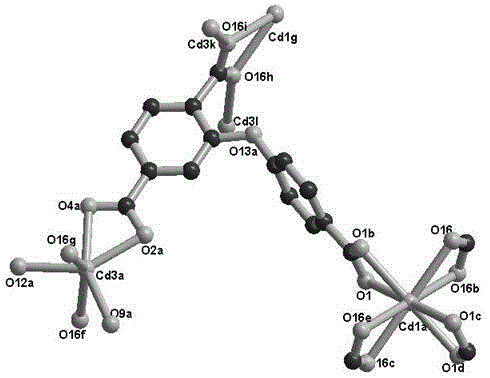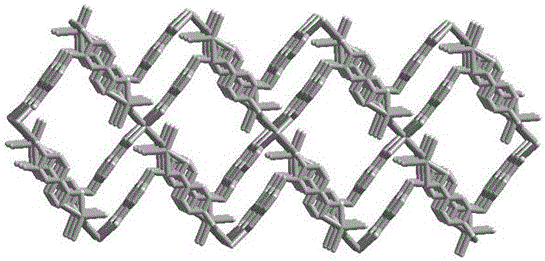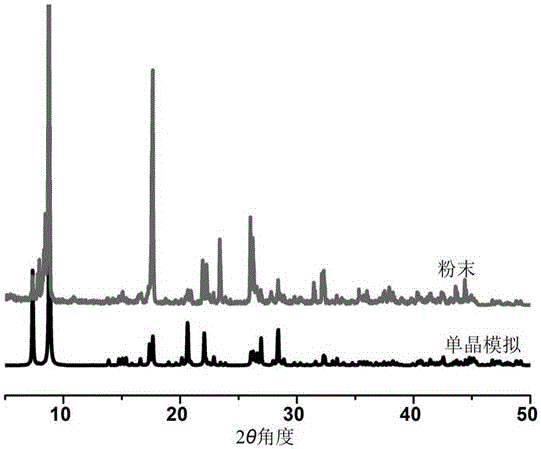Iron ion fluorescent probe porous material and preparation method thereof
A technology of fluorescent probes and porous materials, applied in the field of synthesis of functional porous coordination polymer materials, can solve problems such as poor control of three-dimensional pore size, poor thermal stability of porous structures, complex synthesis conditions, etc. The effect of controllable appearance rules and simple preparation process
- Summary
- Abstract
- Description
- Claims
- Application Information
AI Technical Summary
Problems solved by technology
Method used
Image
Examples
Embodiment 1
[0024] A preparation method for an iron ion fluorescent probe porous material, comprising the steps in turn:
[0025] 1) Weigh 0.1 mmol of solid powder 2-(4-carboxyphenoxy)terephthalic acid and dissolve it in 5 mL of distilled water at a temperature of 75°C, add the prepared 1M sodium hydroxide to adjust the pH of the solution to 6.5, and sonicate for 5 minutes After heating and stirring for 30 minutes, the ligand is completely deprotonated;
[0026] 2) Weigh 0.1mmol of cadmium nitrate and add it directly to the solution prepared in 1), the molar ratio of divalent metal cadmium to 2-(4-carboxyphenoxy)terephthalic acid is 1:1, and stir for 10 minutes to appear white turbid liquid;
[0027] 3) Configure a ternary mixed solvent system: mix 5mL of methanol, 5mL of acetonitrile and 10mL of distilled water in a volume ratio of 1:1:2, and stir at room temperature for 30 minutes;
[0028] 4) Mix the prepared solutions of 2) and 3) together and continue to stir for one hour, then sea...
Embodiment 2
[0031] A preparation method for an iron ion fluorescent probe porous material, comprising the steps in turn:
[0032] 1) Weigh 0.05mmol of solid powder 2-(4-carboxyphenoxy)terephthalic acid and dissolve it in 5mL of distilled water at 80°C, add the prepared 1M sodium hydroxide to adjust the pH of the solution to 6.5, and sonicate for 5min After heating and stirring for 30 minutes, the ligand is completely deprotonated;
[0033] 2) Weigh 0.075mmol of cadmium nitrate and add it directly into the solution prepared in 1), the molar ratio of divalent metal cadmium to 2-(4-carboxyphenoxy)terephthalic acid is 1.5:1, stir for 10 minutes and white turbid liquid;
[0034] 3) Configure a ternary mixed solvent system: mix 4mL of methanol, 4mL of acetonitrile and 12mL of distilled water in a volume ratio of 1:1:3, and stir at room temperature for 30 minutes;
[0035] 4) Mix the prepared solutions of 2) and 3) together and continue to stir for one hour, then seal the mixed solution in a s...
Embodiment 3
[0038] A preparation method for an iron ion fluorescent probe porous material, comprising the steps in turn:
[0039]1) Weigh 0.05mmol of solid powder 2-(4-carboxyphenoxy)terephthalic acid and dissolve it in 5mL of distilled water at a temperature of 90°C, add the prepared 1M sodium hydroxide to adjust the pH of the solution to 7, and sonicate for 5min After heating and stirring for 30 minutes, the ligand is completely deprotonated;
[0040] 2) Weigh 0.05mmol of cadmium acetate and add it directly to the solution prepared in 1), the molar ratio of divalent metal cadmium to 2-(4-carboxyphenoxy)terephthalic acid is 1:1, and stir for 10 minutes to appear white turbid liquid;
[0041] 3) Configure a ternary mixed solvent system: mix 3mL of methanol, 3mL of acetonitrile and 12mL of distilled water in a volume ratio of 1:1:4, and stir at room temperature for 30 minutes;
[0042] 4) Mix the prepared solutions of 2) and 3) together and continue to stir for one hour, then seal the mi...
PUM
 Login to View More
Login to View More Abstract
Description
Claims
Application Information
 Login to View More
Login to View More - R&D
- Intellectual Property
- Life Sciences
- Materials
- Tech Scout
- Unparalleled Data Quality
- Higher Quality Content
- 60% Fewer Hallucinations
Browse by: Latest US Patents, China's latest patents, Technical Efficacy Thesaurus, Application Domain, Technology Topic, Popular Technical Reports.
© 2025 PatSnap. All rights reserved.Legal|Privacy policy|Modern Slavery Act Transparency Statement|Sitemap|About US| Contact US: help@patsnap.com



